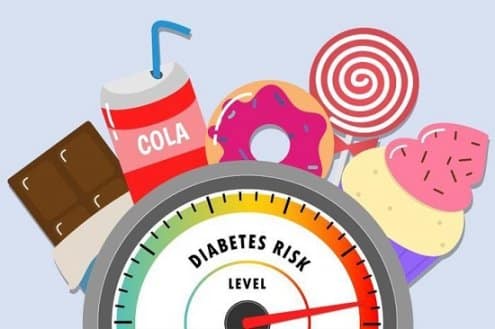Key Takeaways
- Risk comes from both changeable habits and fixed traits.
- Early detection helps prevent complications and supports safer care.
- Simple lifestyle shifts lower risk and improve metabolic health.
- Use screening tests when personal or family risk is present.
Understanding who is at risk of diabetes helps patients and clinicians prioritize screening and prevention. This guide explains major drivers, practical warning signs, and realistic steps to reduce risk. It also highlights groups needing earlier testing and follow-up, which supports safer long-term management.
We use clear, plain language alongside clinical terms. Where needed, we add short glosses, such as dyslipidemia (unhealthy cholesterol), to make concepts easier to apply in everyday decisions.
Who Is at Risk of Diabetes?
Risk builds across time from genetics, life stages, and environment. Excess body weight, low activity, and energy-dense diets raise risk steadily. Family history, prior gestational diabetes, and certain medications also contribute. Specific ethnic backgrounds may face higher rates due to genetics and social factors, including food access and stress exposure.
Metabolic syndrome often clusters several risks together. People with central obesity, high blood pressure, and dyslipidemia (unhealthy cholesterol) carry higher likelihood of glucose dysregulation. Add smoking, poor sleep, and chronic stress, and the risk rises further. Knowing these patterns helps target earlier testing and earlier interventions.
Types of Diabetes and Why Risk Differs
Risk factors do not act the same across diabetes types. Insulin resistance drives most adult-onset cases, while autoimmune processes trigger beta-cell injury in youth and some adults. Some subtypes, such as latent autoimmune diabetes in adults, blur traditional categories and can delay correct treatment if unrecognized.
For deeper subtype differences, see Types of Diabetes for context on classification and care considerations, and review Latent Autoimmune Diabetes in Adults for features that overlap with both autoimmune and insulin-resistant patterns.
Autoimmune (Type 1) Pathway
Autoimmunity targets pancreatic beta cells, reducing insulin production over time. Family history and specific HLA genes increase risk, but onset can occur without known triggers. Viral exposures and other environmental factors are under study. Adults may present gradually and can be misclassified as insulin-resistant, which delays correct therapy. Recognizing faster weight loss, ketosis, and other autoimmune markers helps guide testing.
Insulin-Resistance (Type 2) Pathway
Here, muscle, liver, and fat tissue respond poorly to insulin. The pancreas compensates by producing more insulin until beta cells fatigue. Overnutrition, low activity, visceral fat, and sleep disruption often play roles. Social determinants, such as limited access to fresh foods or safe spaces to exercise, can amplify risk across communities. Evidence-based prevention targets weight, diet quality, and consistent activity.
Many adults develop early signs of Type 2 long before diagnosis. Spotting these patterns enables practical changes and timely testing.
Modifiable Risk Factors You Can Address
Several daily habits and health conditions can be improved to reduce risk. Weight management, balanced nutrition, regular activity, and healthy sleep all help glucose control. Avoiding tobacco, moderating alcohol, and treating high blood pressure or cholesterol also support metabolic health. These shifts are achievable in small, consistent steps.
If you want structured activity guidance, see Exercise Tips to Manage Diabetes for safe ways to build movement. For some with excess weight, anti-obesity medications may be considered by clinicians; for background on one option’s role in weight management, see Wegovy as part of a broader lifestyle plan. For blood pressure control, which supports cardiovascular risk reduction, see Telmisartan as an example class option to discuss with a prescriber.
Excess sugar-sweetened beverages, refined grains, and energy-dense snacks can push glucose higher. Improving protein, fiber, and unsaturated fats supports satiety and steadier glycemia (blood sugar). These changes represent modifiable risk factors of diabetes that can be acted on early.
Non‑Modifiable Risk Factors to Recognize
Some risks cannot be changed but still guide screening. Family history, prior gestational diabetes, and certain ethnic backgrounds raise the baseline likelihood. Aging also increases risk because beta-cell function declines and body composition shifts, even with stable weight. Knowing these elements helps decide when to test and how often to follow up.
For a broad summary of population-level patterns, review the CDC risk overview, which outlines demographic and clinical contributors to disease. In practice, clinicians combine age, family history, and pregnancy history with weight and lab data to individualize decisions. These are non modifiable risk factors for diabetes that warrant attention during routine care.
Early Signs, Screening, and Diagnostic Tests
Watch for thirst, frequent urination, fatigue, blurred vision, and slow-healing wounds. These are classic type 2 diabetes signs and symptoms, but they overlap with other conditions. Unexplained weight loss and ketosis suggest autoimmune processes and need urgent evaluation. Subtle post-meal spikes can appear years earlier, especially with central obesity or prediabetes.
Testing options include A1C (glycated hemoglobin), fasting plasma glucose, and oral glucose tolerance tests. Post-meal checks can uncover hidden spikes; for practical context, see Postprandial Hyperglycemia Guide to understand after-meal patterns. The USPSTF screening recommendation supports screening overweight adults within defined age ranges. For symptom recognition and next steps, compare Type 2 Symptoms and Treatment with Early Signs of Type 2 to time your evaluation.
Prevention and Protective Factors
Small, durable changes help the most. Aim for consistent movement, improved diet quality, and modest weight loss if needed. Whole grains, legumes, fruits, vegetables, and unsaturated fats support better glycemia. Structured sleep and stress management also help reduce glucose variability and cravings.
For meal planning ideas, see Diet for Prediabetes for practical food swaps. Low‑carbohydrate approaches can work for some; for trade‑offs and safety notes, see Keto Diet and Diabetes in the context of medications and activity. The ADA Standards of Care outline prevention strategies clinicians use, including lifestyle programs and, for select high‑risk adults, pharmacologic options. These steps explain how to prevent diabetes in everyday practice.
Special Populations and Life Stages
Certain groups deserve earlier attention. Youth with obesity, adults with polycystic ovary syndrome, and people with a history of gestational diabetes face higher risk. In older adults, functional limits and multimorbidity can complicate diet and exercise planning. Clear, individualized targets help balance safety and independence.
Age increases risk through multiple pathways. If you have wondered, is age a risk factor for type 2 diabetes, the answer is yes, mainly through changes in body composition and insulin sensitivity. For genetic subtypes that present in adolescence or early adulthood, see Maturity-Onset Diabetes of the Young to understand monogenic risk. For weight-related factors in autoimmune disease, see Type 1 and Obesity for a discussion of how excess adiposity interacts with glycemia.
When to Seek Care and Treatment Basics
Seek care promptly if you notice persistent symptoms, unintended weight loss, or signs of dehydration. Dizziness, vomiting, severe thirst, or confusion need urgent evaluation. Bring a list of medications, supplements, and family history to support accurate assessment. Tracking home readings can help clinicians understand daily patterns and make safer plans.
Therapy differs across types. Autoimmune cases require early insulin replacement and structured education; this is central to type 1 diabetes treatment. For insulin‑resistant cases, treatment often begins with lifestyle changes and may add medications targeting glucose production or sensitivity. If you need help measuring at home, the Freestyle Freedom Lite Meter can support accurate testing and documentation for clinic visits.
Practical Tools and Next Steps
Start with a simple plan: measure, move, and modify one habit weekly. Keep a short log of meals, activity, and sleep. Discuss results at routine visits to update your plan safely. Many people benefit from structured programs that pair nutrition guidance with gradual activity.
Review our Diabetes Articles for condition overviews and step‑wise guides you can discuss with your clinician. For supplies that support home monitoring and pattern tracking, explore Diabetes Supplies for meters and strips. If combination therapy is discussed in care plans, see Janumet XR to understand ingredients clinicians may consider for insulin resistance. For flexible testing on the go, the Onetouch Verio Flex Meter may help you capture readings during normal routines.
Recap
Diabetes risk reflects both personal choices and fixed traits. Early recognition and testing reduce delays and prevent complications. A practical plan combines movement, diet quality, sleep, and targeted care. Step‑wise changes offer better results than quick fixes.
Use your known risks to set a schedule for screening. Track progress with simple tools and bring questions to your clinician. Realistic changes, done consistently, make a meaningful difference over time.
Note: Screening plans and treatments should be individualized by a qualified clinician based on your health history and current medications.
This content is for informational purposes only and is not a substitute for professional medical advice.


